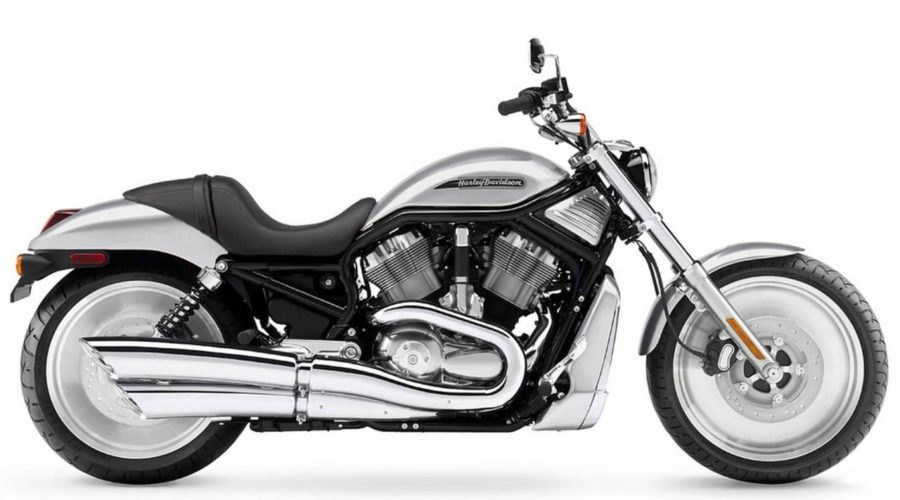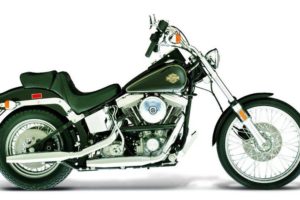2001 Harley-Davidson VRSCA V-Rod
Some bikes you can just climb on, hit the button and ride hard, confident that you know what the bike is about and that it will respond to your slightest command. Most of the current crop of sportsbikes fall into this category.
And then there are some bikes which confound your every attempt to get even the most minimal motorcycling satisfaction. The Harley V-Rod falls into this camp. In fact, after my first ride aboard the V-Rod, through the Royal National Park, south of Sydney, to Stanwell Tops, I was sorely tempted to toss the keys over the edge into the water far below – with the keys still in the bike and the engine running.
That run through the park on a bright warm spring afternoon had been hampered by a front end which had a mind of its own, a bike which wanted to run wide and a chassis which emerged at the end of the Park with metal missing from six separate and distinct areas. It was made far worse by the fact that the engine was rapidly proving itself to be an absolute gem and the brakes were the best any Harley has carried. Ever. So you can imagine my disappointment.

To give you some idea of the state of things, while we were parked at Stanwell Tops we watched the rain rolling north over the escarpment. By the time we had suited up I had exerted my editorial privileges and had handed the keys to the V-Rod to Matt, commandeering the Moto Guzzi California for myself. Despite the Cali being old fashioned and with oldish rubber, I was still quicker through the park, in the rain, than I had been on the V-Rod in the dry.
Despite the V-Rod’s engine and the sticky Dunlop D207s, Matt was a speck in my mirrors after the first few corners, possibly because, in the rain, the short front guard allows spray from the front tyre to be directed straight at visor height…
When we got back to the office after a cancelled photo shoot and a wet ride, I was one disappointed bike journo. How, after all the hype, was I supposed to tell Harley that they’d made a big mistake?
The next day dawned fine and dandy, so Matt and I decided to have another bash at the photos. Same destination, same tackle, same riders. Only this time we took the freeway. No way was I riding though the park again. Having checked the rear preload – the only suspension adjustment available on the bike – and finding that it was on position two out of five, the first destination was Frasers at Wollongong. Once there, we upped the preload to position four out of five with the special tool. Trying to adjust the suspension with the old screwdriver in the hole trick was only going to tear the hole in the adjustment ring, so it was a better bet.

In addition, I got them to drop the levers a bit, by swivelling the handlebar control assemblies. This also took special tools, as they are retained by Torx star nuts. The levers themselves are thick blade types and I found my hands were sensitive to their placement in a way not so with the thinner units found on most other bikes. We couldn’t adjust them to my preferred position since the indicators, which are also mounted on the assemblies, fouled the tank, but we did get them better.

It was a lesson in suspension adjustment for me. It never ceases to amaze me how a small adjustment to suspension can completely alter a bike. Two extra notches of preload transformed the steering from running wide to tracking true, the ground clearance from woe to go and the bike from a worry to a weapon. As a by-product, I found at least an extra 25km/h in cornering speed.
Where before the bike would wallow under brakes, self steer into a corner and then bounce upright when it ground into the tarmac, now it was stable, assured and I could finally get the tyres to deliver on their promise. Totally amazing. Instead of braking hard, tip-toeing around a corner and then hitting the go juice, I could power all the way through a corner confident in the knowledge that when (not if) the bike started scraping, there would be more than enough feel, feedback and stability for me to keep the power on.

This was all because of a change in rear preload and therefore ride height. Upping the preload raised the rear end by all of, maybe, 10mm, but that was enough to steepen the steering angle, to put a bit more weight on the front wheel and to cure a multitude of ills.
There was another, less expected, benefit. As delivered, the bike would, once speeds reached 120-130 km/h on the freeway, start to wander. It was a combination of the windsock effect with me spreadeagled aboard the V-Rod and a rearward weight bias. It was never a problem, but became tiring as the bike described its own path along the southern freeway with little regard to my peace of mind. After the suspension change, the effect was immediately removed. Strange, but true.
From then on, the test went swimmingly. The engine came into its own, the brakes made sense and the bike was brilliant. The riding position was bloody good, and the seat was bloody good and the helmet/instrument binnacle assembly deflected the wind nicely at chest level, leaving my helmet in nice, quiet, still air. And the suspension, despite offering only 100mm of travel at the front, proved compliant and comfortable with seemingly ideal spring/damping ratios.
There are still ground clearance issues, but clearance became an indicator of how hard I was riding and not the scary, edge-of-disaster thing it was before. Harley is on a winner. The slightly odd self steering remains – the bike turns in nicely and then seems to fall into the corner – but the effect is drastically reduced and it became a quirk which could be taken into account rather than a problem which had to be ridden around.

The V-Rod, as we described in TW September, has grown out of the company’s VR racebike experience. The 60-degree liquid-cooled V-twin (engineered by Porsche — Ed.) is a complete departure from Harley’s 45-degree air/oil-cooled norm and, as such, will be a challenge for the traditionalist. I can’t see too many patch wearers rushing out to buy a V-Rod, and so Harley will be hoping for a result similar to BMW’s experience with the F650, which carved out its own market niche (to the tune of 10,000 units in quick smart time) without cannibalising existing sales, and I reckon the Milwaukee company is in with a chance.
There is no real competition for the bike in the marketplace. It’s long, lean and low. It looks mean as when it’s parked, and even meaner in its dragbike guise, as the specially tricked-up unit at the world launch proved. You can rest assured that there is a pretty full range of Screamin’ Eagle accessories on the boat headed out here as well, so it can only get leaner and meaner. In terms of true, on the road, competition, only the Moto Guzzi California series gets close and, while the Cali will run rings around the V-Rod when it comes to handling and clearance, the Harley has it all over the Cali in looks, engine and tyres.
Since when has a Harley fitted Supersport race-spec tyres as standard? The Dunlop D207 Sportsmax rubber is well known in ride day and Proddie race circles and allows the Harley braking and cornering performance hitherto only dreamed of by cruiser riders.
It is brilliant, but – and don’t you hate that but – the sizes are unique to the V-Rod. The front is a 120/70 ZR19 and the rear is a 180/55 ZR18 (normal supersport rubber comes in 17-inch sizes) and therein lies a problem. No one else makes tyres to suit the V-Rod yet, and so replacement rubber is going to be a) scarce; and b) expensive until other tyre companies start including these sizes in their ranges. Quoted NSW RRPs for the US-made Dunlops are $342 for the front and $439 for the rear. The same thing often happens with new sportsbikes as well, so it’s not just a Harley thing, but the H-D sizes are more odd than the sportsbike variations.
On the upside, of course, is the fact that the V-Rod won’t chew through tyres as quickly as a dedicated sportsbike will, and should be slightly more forgiving of profile changes as the tyres wear. And, unlike most sportsbikes, the Harley is almost as much fun when it is parked as when you are riding it — if you like talking about your new pride and joy, that is. I can’t think of any other bike which attracts so much attention or comment. Stop for fuel or for a smoke and you’ll be inundated with comments ranging from outright abuse (“That’s not a real f*#*ing Harley.”) to open admiration (“That’s just a beautiful bike.”).


There is no such thing as anonymity with this bike. Get used to it because it’ll happen a lot. With a fuel tank under the seat holding only 14 litres, you’ll be fending off admirers every 150km or so. Speaking of the fuel range, the odometer has a handy function which lets you know approximate distance left before you have to park and walk. Hitting the tripmeter button (mounted under the instrument binnacle) scrolls through odometer, tripmeter and remaining kilometres display.
The display controller is throttle position dependent to take into account how hard you are riding, so after you fill up and, say are cruising the freeway at 110km/h, it’ll tell you you have about 170km left before refuelling. When you roll off the throttle, the amount available will rise and, conversely, when you gas it up it’ll fall. It was showing 174km left for about the first quarter of a tank, and then fell progressively to when the tank was a quarter full and the message changed to Lo, which reduces its value somewhat as it is in the last quarter tank when you really need to know how many kilometres you have left.
Incidentally, a nice feature of the instruments is that the needles for the tacho and the fuel gauge change colour to red (at redline and at a quarter full respectively). Neat.
Although the testbike was a pre-production model and therefore carrying some things which may well be changed for final production, most of the bike is very well thought out. The ignition switch, mounted below your right bum cheek, operated the ignition and the accessory position and, when turned anti-clockwise, opens the seat revealing the fuel cap. Careful when you fill up, though, because every time I filled up the fuel spat back and formed a nice little puddle in the rubber tank surround. Although there is a drain hole fitted, I preferred to mop it up with paper towel – maybe I’m anally retentive, but I hate the idea of raw petrol dripping anywhere other than into a fuel tank. The ignition key also operates the separate steering lock on the steering head. There was also a slight oil weep from the fork seals, which might reflect the roughness of our roads and the kicked out nature of the front end increasing stiction, but is probably also accounted for by the pre-production nature of the bike.

I have already mentioned the control levers, and the necessity of having them moved to suit the rider at the dealership, but you might also want to consider having the shop adjust the gearshift pedal, too. Normally, a gearshift linkage has two threaded ends with locknuts screwed into rose joints. To adjust the pedal, all you have to do is to loosen the locknuts, rotate the shaft until the pedal is in the correct position, and then retighten the locknuts. With the V-Rod, there is only one threaded adjuster, which means you have to undo one of the rose joints, make the adjustment, refit the rose joint, check the position and then repeat as often as necessary. A small detail and one, when done once is forgotten, but something to bear in mind once you have shelled out the $30,500 asking price.
So, Harley’s new V-Rod. Take the time to set it up and it’s brilliant. Our test bike was delivered with 39 km on the clock. When I asked H-D tech guru Graeme Barnes about run-in procedure and warming up rituals his pithy comment was: “Turn the ignition on, press the button, ride away.” Boy, have times changed! The sophisticated fuel injection and modern as you like manufacturing processes mean the bike is ready to roll from the outset. And it’s true: the injection is great from start to finish, with no stumbles or trips and none of the constant throttle hunting often associated with injection. I couldn’t believe it’s not carbed.
As is often the case with modern engines, though, there is the price of heat to be paid in return for performance and the V-Rod mill does run hot, very hot. There’s no temperature gauge, but I reckon it’d be up there with some of the Triumphs at around 110-112 degrees. Not so much fun on a hot day in traffic, but if you needed any other excuse to take the long way, then this is it. Incidentally, perhaps the bike was running a bit lean to meet ADR pollution requirements and fitting a Screamin’ Eagle kit might alleviate the problem. Just a thought, and remember, “Not for highway use” …
Judging by the bike’s performance, even in ADR-spec, and the polarity of the responses it received, Harley can be very pleased with the result of its massive R&D spend.

The bike is going to attract a loyal following pretty quickly and the division it has already created within the Harley camp will make sure that it will continue to create interest wherever it goes. A lot of the comment from detractors runs along the lines of the bike looking Japanese (as if that is an insult). It doesn’t. It just reflects the best practice to which all manufacturers aspire.
On the other hand, as the Japanese factories continue to build better and better cruisers to compete in the cruiser market in which Harley has long been king – and have begun to build performance models to extend their ranges – Harley has slipped the V-Rod under their guard, refusing to play the capacity card, but instead fitting a relatively small bore 1130cc motor – the Sportster 1200 has a larger engine – which is built for straight line speed into a sweet-handling chassis. This is what is known as upping the ante.
In real terms, Harley “designed in 1903 and nothing has changed since” Davidson has just leap-frogged the 20th century. The splash made by the V-Rod will send out ripples through the world of motorcycling which will change the way we look at the Made in America tag. At last, H-D is back, Willie G. is mad, and he’s not going to take it any more.
By Jeremy Bowdler. Two Wheels, December 2001





